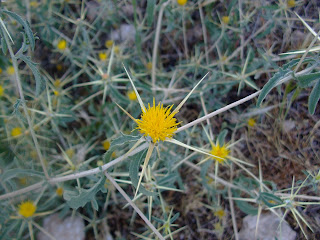 As you can see, we don't get the credit for this pic! We were way too far off for a good one but this shot by Lubomir Hlasck really does them justice.
As you can see, we don't get the credit for this pic! We were way too far off for a good one but this shot by Lubomir Hlasck really does them justice. Cool conditions continue.
Another slight temperature drop.. range from just over 9 degrees C to 16.5 degrees C. It was about 14 degrees C and falling when we headed down to the valley at about 6.20 p.m. Humidity was 65%, winds W/NW 5-8 kt.
Bird of the day today was the roller, Coracias garrulus. Two of them, hunting way over at the north end of gazelle field. They moved about quite a bit, hopping up onto rocks or shrubs or the lines over the field, then returning to the ground, though they didn't stay far from each other. If they are a pair, perhaps they are or will breed in the area though it's far more likely they're just passing through. We saw one individual on the lines about this time last year. Their blueness with a hint of turquoise is visible from quite a distance and my husband was also able to make out the dark eye stripe. These are special birds so naturally I was thrilled to see them here again.
We also watched a Eurasian sparrowhawk heading west towards the north forest pines about sunset and heard many clear melodious calls of stone curlews. Greenfinches were busy in the pines again and Eurasian jays were active. Blackbird song was heard and graceful warblers were vocal. In the garden, white spectacled bulbul, sunbirds, house sparrows and laughing doves were all heard.
Ballotia still not flowering enough for a photograph but capers are flowering now, (Capparis spinosa) (photo in last May in my archives) their beautiful large white three petals with hints of purple and bunch of stamens that reminds me of one of those fibre optic lamps. These are the bushes that grow all over the Western Wall and their pods can be pickled and eaten. Husband pulled up a wild carrot. The root was pale, woody and unappetizing but definitely smelled surprisingly carrotish. There are plenty wild plants in the area which can be eaten. The pine nuts from the Aleppo Pines all over the valley are quite delicious.
The hyrax favour the rather astringent cypress trees for some reason. As we walked along valley road several dropped out of a cypress tree and ran to their dens. They climb up the trunk and along the branches but they seldom bother to take that route down, they simply let themselves drop. I noticed if we keep walking, however slowly, they allow quite a close by-pass but if I stop moving they find that ominous and are more likely to run for cover. Still no gazelle but many boys are still on vacation and are busy scouring the woods for dead wood to be used for bonfire night coming up soon.





































